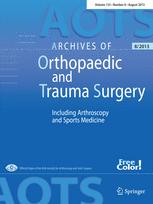
ARTHROPLASTY
Posterior cruciate-substituting vs. retaining TKR in patients with high varus deformity
This report has been verified
by one or more authors of the
original publication.
Arch Orthop Trauma Surg. 2016 Jul;136(7):999-1006.
56 patients with knee osteoarthritis and varus deformity (>10 degrees) were randomized to undergo total knee replacement with either a posterior cruciate-substituting (PS) or cruciate-retaining (CR) prosthesis. The purpose of this study was to the determine the effect of these different devices on postoperative range of motion and knee function when compared over a 7-year follow-up period in patients with a varus deformity. Results demonstrated that patients in the PS group had significantly greater active/passive flexion angles, KSS knee scores at 3 and 12 months, and KSS function scores at 3 months when compared to the CR group. However, patients in the CR group demonstrated significantly shorter time required to perform straight-leg-raising exercises when compared to the PS group.
Unlock the full ACE Report
You have access to {0} free articles per month.Click below to unlock and view this {1}
Unlock NowCritical appraisals of the latest, high-impact randomized controlled trials and systematic reviews in orthopaedics
Access to OrthoEvidence podcast content, including collaborations with the Journal of Bone and Joint Surgery, interviews with internationally recognized surgeons, and roundtable discussions on orthopaedic news and topics
Subscription to The Pulse, a twice-weekly evidence-based newsletter designed to help you make better clinical decisions
Exclusive access to original content articles, including in-house systematic reviews, and articles on health research methods and hot orthopaedic topics
Or upgrade today and gain access to all OrthoEvidence content for just $1.99 per week.
Already have an account? Log in


Subscribe to "The Pulse"
Evidence-Based Orthopaedics direct to your inbox.
{0} of {1} free articles
Become an OrthoEvidence Premium Member. Expand your perspective with high-quality evidence.
Upgrade Now













































































